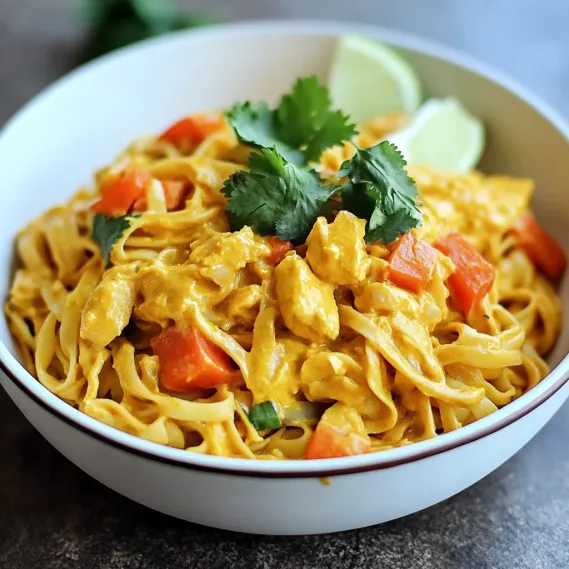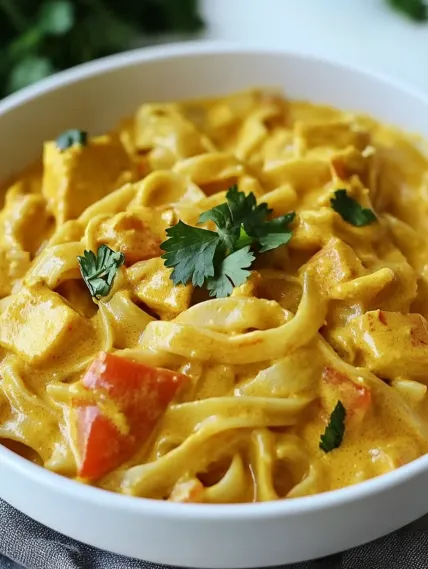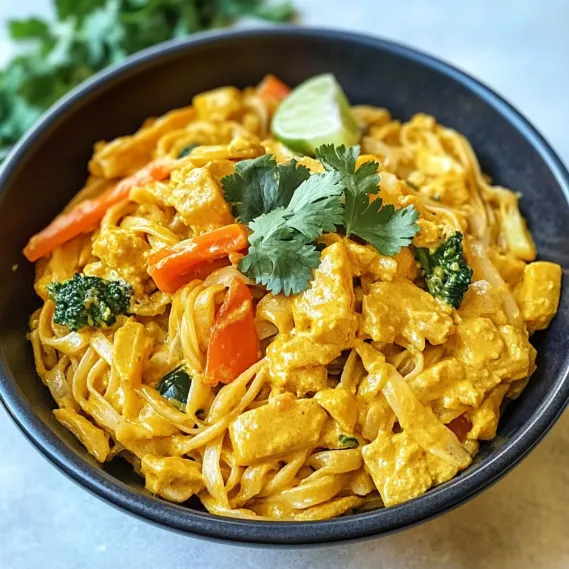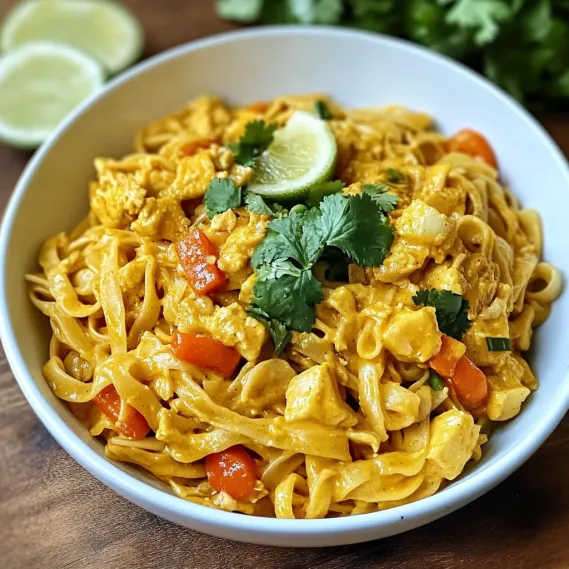 Pin it
Pin it
These 15-minute Yellow Curry Noodles deliver a perfect blend of creamy coconut milk and vibrant curry flavors, wrapped around tender rice noodles and colorful vegetables. A quick yet impressive meal that brings authentic Southeast Asian flavors to your table with minimal effort. I discovered this recipe during a particularly busy week and was amazed at how these simple ingredients created such a satisfying dish in just minutes.
Last month, I made this for a quick weeknight dinner, and my partner who usually finds curry 'too heavy' went back for seconds. The secret? The perfect balance of aromatic curry paste with creamy coconut milk creates depth without overwhelming heaviness.
Essential Ingredients and Selection Tips
- Rice Noodles: Look for medium-width or wide rice noodles for the best texture
- Yellow Curry Paste: Mae Ploy or Maesri brands offer authentic flavor
- Coconut Milk: Full-fat provides the richest, creamiest sauce
- Fresh Ginger: Use a microplane for easy grating; frozen ginger works in a pinch
- Mixed Vegetables: Choose a colorful variety for both nutrition and visual appeal
The magic happens when the aromatic curry paste blooms in the pan, releasing its complex flavors before being enriched with creamy coconut milk to create a sauce that clings perfectly to every strand of noodle.
Detailed Cooking Instructions
- Step 1: Prepare the Noodles
- Bring a large pot of water to a boil. Add rice noodles and cook according to package directions, usually 6-8 minutes or until tender but still slightly firm. Drain in a colander and rinse briefly under cold water to stop cooking and prevent sticking.
- Step 2: Sauté the Aromatics
- Heat olive oil in a large skillet or wok over medium heat. Add diced onion and sauté for 2-3 minutes until softened and translucent. Add minced garlic and grated ginger, cooking for another minute until fragrant but not browned. These aromatics form the flavor foundation of your dish.
- Step 3: Bloom the Curry Paste
- Add yellow curry paste to the aromatics and stir constantly for 1-2 minutes. This crucial step 'blooms' the spices, activating their essential oils and developing deeper flavor. The paste should become fragrant and slightly darker.
- Step 4: Create the Sauce
- Pour in the coconut milk, soy sauce, and sugar. Stir to combine thoroughly with the curry paste, ensuring no lumps remain. Bring the mixture to a gentle simmer, allowing the flavors to meld together.
- Step 5: Cook the Vegetables
- Add your mixed vegetables to the simmering sauce. Cook for 3-5 minutes, depending on the vegetables used, until they're tender-crisp. Avoid overcooking to maintain vibrant colors and nutrients.
- Step 6: Combine with Noodles
- Add the drained rice noodles directly to the skillet with the curry sauce. Use tongs to gently toss until all noodles are evenly coated with the golden sauce and the vegetables are well distributed.
- Step 7: Final Flavor Adjustments
- Taste and adjust seasonings if needed. A little more salt might enhance the flavors, while a drizzle of lime juice can brighten all the flavors.
- Step 8: Garnish and Serve
- Transfer to serving bowls or a large platter. Garnish with fresh cilantro leaves and a sprinkle of chopped peanuts for color and texture. Serve immediately while hot and fragrant.
 Pin it
Pin it
I learned the importance of properly blooming the curry paste after my first attempt resulted in a less flavorful sauce. Taking those extra minutes to let the spices develop makes all the difference in the final dish.
Budget-Friendly Meal Planning
This dish exemplifies economical cooking, costing under $3 per serving. Rice noodles are inexpensive and filling. The curry paste, once purchased, lasts for multiple meals. Use seasonal vegetables for the best prices, or incorporate leftover veggies from your crisper drawer. This prevents food waste while creating a nutritious, satisfying meal that stretches your grocery budget beautifully.
 Pin it
Pin it
Family-Friendly Adaptations
For households with varying spice preferences, this recipe offers simple modifications. Reduce or omit the ginger for milder flavor. For children who might be hesitant about spice, start with just rice noodles in their curry sauce, gradually introducing more aromatics as they become accustomed to the flavors. My niece prefers hers with extra vegetables, while my nephew adds chicken to his.
Seasonal Vegetable Variations
This versatile curry welcomes seasonal produce throughout the year. Summer brings opportunities for zucchini, bell peppers, and green beans. Fall calls for butternut squash and mushrooms. Winter versions incorporate hearty greens like kale or frozen vegetable blends. Spring welcomes asparagus and snap peas. These adaptations keep the dish exciting year-round while making the most of what's fresh and affordable at your market.
Make-Ahead and Freezer Tips
For busy households, this recipe shines as a prepare-ahead solution. Make a double batch of curry sauce and refrigerate for up to 3 days. Cook fresh noodles when ready to serve, or prepare individual portions in containers for grab-and-go lunches. The flavors actually improve after a day in the refrigerator, making this perfect for meal planning. For longer storage, freeze the sauce in airtight containers for up to three months.
Chef's Essential Tips
- For extra flavor, add a teaspoon of red or green curry paste along with the yellow
- Toast the curry paste in a dry pan before using for added crispiness
- Add a pinch of turmeric for subtle warmth and color
- For a thicker sauce, simmer uncovered for a few extra minutes
- For a spicier version, add sliced fresh chilies or a teaspoon of chili oil
I discovered these refinements over many iterations of this dish - particularly the turmeric addition, which adds remarkable depth to the flavor profile without being identifiable as turmeric.
This versatile curry has become my reliable go-to when I need a quick yet satisfying meal. The combination of aromatic spices, creamy coconut milk, and fresh vegetables creates something greater than the sum of its parts - a dish that feels like it took hours to develop its flavors, yet comes together in minutes.
 Pin it
Pin it
This Yellow Curry Noodles recipe proves that delicious, satisfying meals don't require complicated techniques or hard-to-find ingredients - just thoughtful preparation and quality basics that come together in harmony.
Frequently Asked Questions
- → Where can I find yellow curry paste?
- Yellow curry paste is available in the international aisle of most major grocery stores, in Asian markets, or online. Popular brands include Mae Ploy and Thai Kitchen.
- → Can I add protein to this dish?
- Absolutely! Tofu, chicken, shrimp, or thinly sliced beef all work well. Add tofu with the vegetables; for meat or shrimp, cook it first in the pan before the aromatics, then remove and add back in with the noodles.
- → Is yellow curry spicy?
- Yellow curry is generally milder than red or green Thai curries, with a warm rather than hot spice profile. However, heat levels can vary by brand, so check your curry paste's label if you're sensitive to spice.
- → What type of rice noodles should I use?
- Medium or wide rice noodles (pad Thai style) work best for this dish, but thin rice vermicelli will also work. In a pinch, you could even substitute linguine or fettuccine.
- → Can I make this ahead of time?
- While best enjoyed fresh, you can prepare the curry sauce ahead of time and refrigerate for up to 2 days. Cook the noodles and vegetables just before serving for the best texture.
